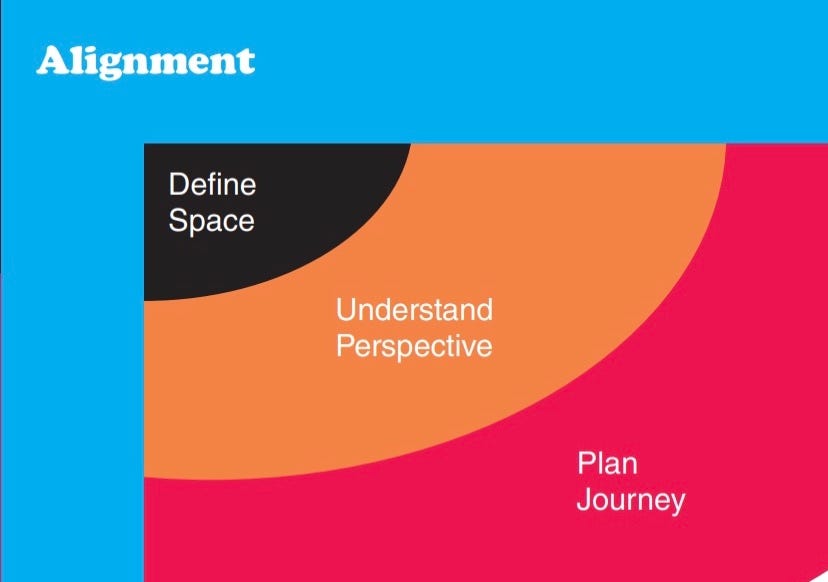
Alignment has been coming up in a lot of my reading over the last year. In books on Wayfinding, Time Perception, Dissent, Kindness and Leadership it’s the anchor of alignment that comes thru as a common theme.
The need to be aligned at the start of a project or journey but also the need to be deeply wary of alignment as the project or journey continues.
What is Alignment?
I’m going to borrow a section from another post on Wayfinding.
Alignment is fundamental to human navigation and cognition. It is the starting point.
Alignment is about how a person senses which way they are pointing.
This is the fundamental idea of orientation in a space. If this goes wrong at the start then everything goes wrong thru the journey.
Think of coming out of an underground metro railway station. You step out the door and look around. This is the moment of alignment. All cognitive maps will be anchored to this sense of direction.
This can be confusing. For example, in London, people can find it hard when they try to match their senses of orientation (coming of out of underground stations) when they walk around more widely and discover other stations they have come out of. Each station is a node of personal alignment and each of their personal moments may be misaligned from each other.
Being clear about which way a person is pointing when they start out matters. Even if it’s just an arrow pointing North. It allows alignments to match up: both within an individual and between groups of people.
What needs to be added to that idea of alignment in place is that alignment in time and in social situation are also important. In books by Daniel Pink and others, the idea of strongly enforcing an opening sense of time and structures comes up as a way of binding a group together and providing a sense of where to start and where to go.
Alignment as an anchor matters. The journey starts with knowing where you are anchored before you let go and start out on the voyage.
Good Alignment
Alignment in place, in time and in social connection is crucial to any project. Fail to be explicit about the rituals of starting a journey together and the journey will be much harder and the final destination may be very disappointing.
Humans need a sense of where, when and who they are at the start.
If you are badly aligned at the start of a journey you are both more likely to get lost along the way and less likely to reach your destination at all.
Bad Alignment
However, that need for alignment at the start of the journey is too often confused with a need to maintain alignment thru the journey.
Particularly with projects this is not good. Strong alignment over the project gets caught up in ideas of leadership, management, timekeeping, meeting attendance, convergence and group think. All of these can be damaging when too strongly applied.
Diversity and divergence cannot thrive when uniformity and convergence are applied in all places, at all times for all people.
The key point here is to spend more time at the start ensuring people feel a shared sense of being together and then progressively let go. In one book on Mesolithic societies, it is interesting how leadership was an intervention; a momentary role not a permanent position or structure. Using authority temporarily to align people is good. Using authority permanently to control people is not.
Balancing Alignments
Good alignment means organisations putting more effort into things before they start the thing they believe is the project.
Good alignment anchors people to good outcomes which may well be vastly different to what was imagined at the start.
Bad alignment needs to be avoided by enabling people’s sense of independence and autonomy as they move thru the project.
Removing that strong sense of authority that can be helpful, particularly with groups of people who have only just met, in creating that preliminary alignment.
Letting the power of friendship and shifting patterns of interventionary leadership guide the group to the destination.